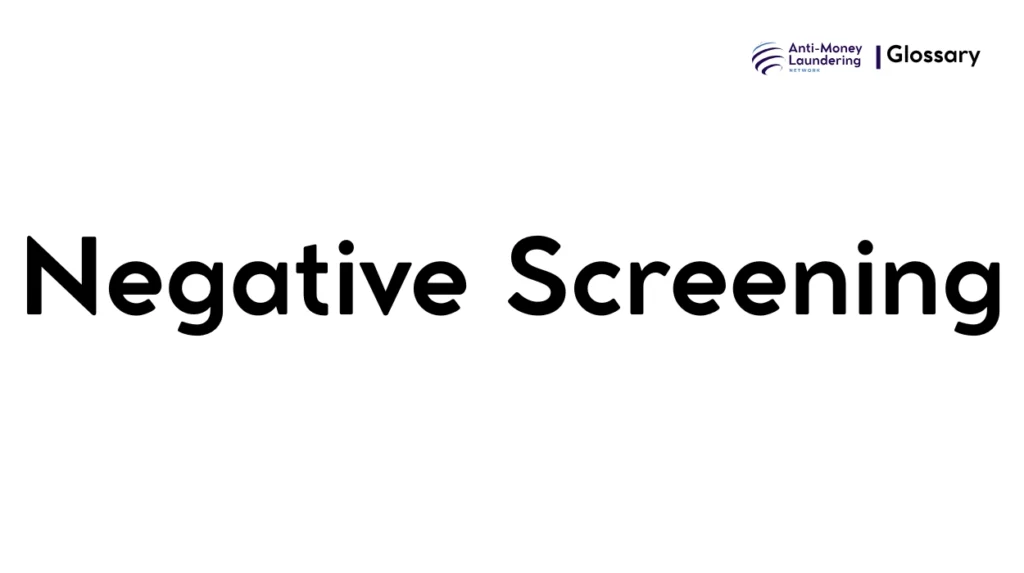Definition
Negative Screening in Anti-Money Laundering (AML) refers to the process of systematically checking individuals, entities, or transactions against lists or sources containing adverse or negative information to identify potential risks related to money laundering, terrorist financing, or other financial crimes. This includes screening against sanctions lists, watchlists, politically exposed persons (PEPs) lists, and negative news or adverse media sources that reveal possible involvement in illegal or unethical activities.
Purpose and Regulatory Basis
Negative Screening serves as a critical component of AML compliance to prevent financial institutions from engaging with high-risk or illicit actors. Its purpose is to uncover hidden risks that may not appear in traditional customer due diligence by identifying connections to criminal conduct, sanctions violations, or reputational threats. Regulatory frameworks such as the Financial Action Task Force (FATF) Recommendations, the USA PATRIOT Act, and the European Union Anti-Money Laundering Directives (AMLD) mandate the use of negative screening practices to ensure effective risk management and compliance with global AML standards.
When and How it Applies
Negative Screening is applied during various stages of a financial institution’s customer lifecycle:
- Onboarding: Before establishing a relationship, customers are screened for any negative information from sanctions lists or adverse media to identify red flags.
- Ongoing Monitoring: Regular screenings are conducted to detect newly emerged risks or changes in a customer’s status, such as new adverse media coverage.
- Trigger Events: Specific events like suspicious transactions or changes in ownership may prompt targeted negative screening.
Examples include finding media reports alleging fraud against a prospective customer or discovering an entity’s presence on a sanctions list, which then triggers enhanced due diligence or denial of service.
Types or Variants
Negative Screening can be classified into the following types:
- Sanctions Screening: Checking against official government and international sanctions lists.
- PEP Screening: Identifying politically exposed persons who may pose a higher risk of corruption.
- Adverse Media/Negative News Screening: Searching a broad range of media sources for any negative news related to customers, such as criminal allegations, fraud, or regulatory breaches.
- Watchlist Screening: Checking against various watchlists maintained by regulatory, law enforcement, or industry bodies.
Procedures and Implementation
Financial institutions implement Negative Screening through structured steps:
- Data Collection: Compile customer data and relevant identifiers (names, aliases, dates of birth).
- Screening Software: Use specialized technology to scan sanctions lists, PEP lists, and multiple media sources including print, online news, blogs, and social media.
- Contextual Analysis: Employ natural language processing and human analysts to understand the context and credibility of flagged information.
- Risk Assessment: Integrate screening results into the customer’s risk profile for enhanced due diligence if needed.
- Documentation and Escalation: Maintain records of findings, decisions, and actions taken, escalating suspicious cases as per regulatory mandates.
Impact on Customers/Clients
From a customer perspective, Negative Screening can affect:
- Rights and Access: Customers flagged may experience delays, requests for additional information, or denial of service.
- Privacy and Transparency: Institutions must balance thorough screening with respecting customer privacy and avoiding discrimination.
- Engagement: Customers may be notified or engaged further when negative information requires clarification or remediation.
Institutions are expected to follow fair and consistent policies ensuring compliance without unduly harming customer relationships.
Duration, Review, and Resolution
Negative Screening is an ongoing process:
- Duration: Initial screening at onboarding, followed by periodic or continuous reviews.
- Review: Regularly update screening databases and reassess customer risk profiles.
- Resolution: Negative findings may lead to enhanced due diligence, transaction monitoring, reporting, or termination of relationships depending on severity and credibility.
Regulations often require documented periodic reviews and timely response to new information.
Reporting and Compliance Duties
Institutions have several responsibilities concerning Negative Screening:
- Maintaining Records: Documenting all screening results and decisions.
- Compliance Reporting: Filing Suspicious Activity Reports (SARs) if adverse findings indicate potential illegal activities.
- Regulatory Audits: Preparing for regulatory examinations with evidence of effective screening controls.
- Penalties: Failure to conduct adequate negative screening can result in fines, legal actions, and reputational damage.
Related AML Terms
Negative Screening is closely linked with:
- Customer Due Diligence (CDD) and Enhanced Due Diligence (EDD): Screening results inform these risk-based processes.
- Transaction Monitoring: Alerts from negative screening may trigger transaction reviews.
- Suspicious Activity Reporting (SAR): Negative findings can drive reporting obligations.
- Sanctions Compliance: Negative screening often overlaps with sanctions list screening.
Challenges and Best Practices
Challenges include:
- False Positives: Screening may generate excessive non-relevant alerts, consuming resources.
- Data Quality: Inconsistent or incomplete data hampers accurate screening.
- Context Understanding: Human judgment needed to assess credibility amid potentially biased or outdated media.
Best Practices: - Adopt advanced AI and NLP technologies to reduce false positives.
- Establish clear escalation and review processes.
- Regularly update and customize screening criteria to the institution’s risk profile.
Recent Developments
Recent trends in Negative Screening include:
- Greater use of AI and machine learning to improve detection accuracy.
- Integration of global and multilingual media sources for comprehensive coverage.
- Enhanced regulatory focus post-pandemic on continuous customer monitoring.
- Development of industry standards such as those from the Wolfsberg Group to harmonize negative news screening practices.
Negative Screening is a vital AML process that helps financial institutions identify and mitigate risks posed by customers or entities with adverse or suspicious backgrounds. By combining technology, regulatory guidance, and expert analysis, institutions can protect themselves from financial crime and reputational harm, ensuring robust AML compliance.

